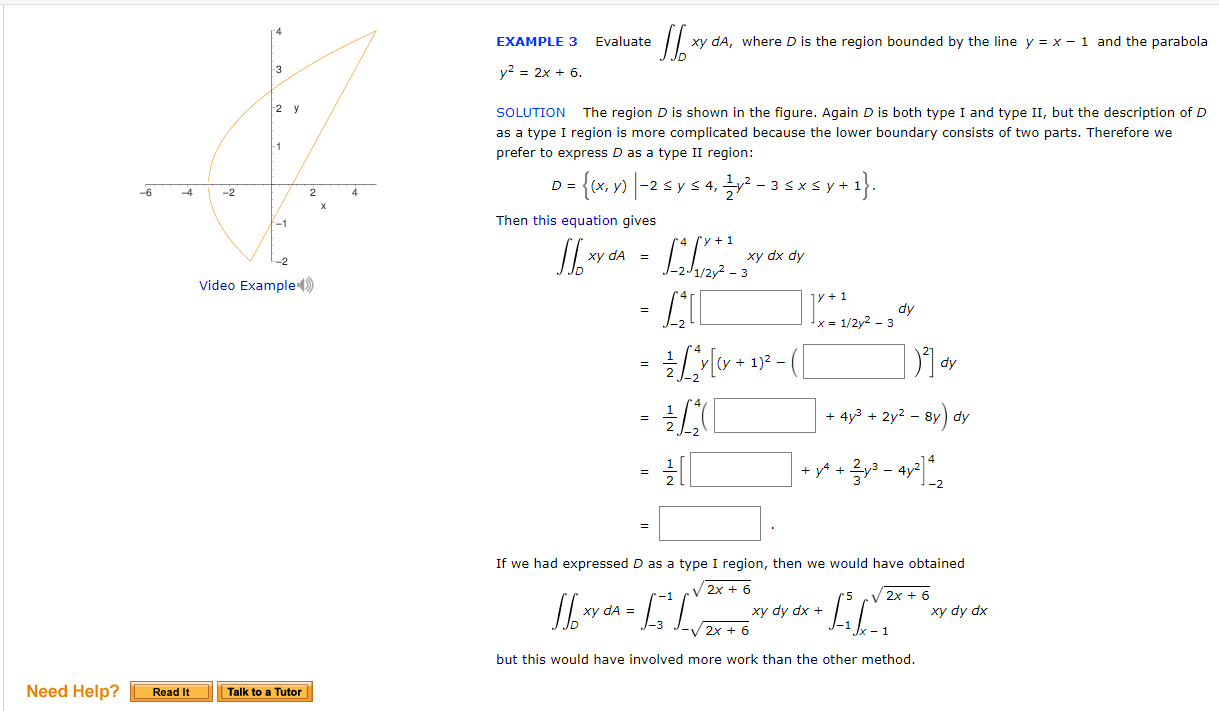EXAMPLE 3 Evaluate xy dA, where D is the region bounded by the line y = x - 1 and the parabola -3 y2 = 2x + 6. SOLUTION The region D is shown in the figure. Again D is both type I and type II, but the description of D as a type I region is more complicated because the lower boundary consists of two parts. Therefore we prefer to express D as a type II region: -1 {ex.v) |-2 5 y s 4, - 3 sxsy+1}. -6 -2 2 Then this equation gives ху xy dx dy J-2J1/2y² - 3 Video Example ) y +1 dy - ly•ar -( + 1)2 dy + 4y3 + 2y2 - 8y) dy +*+ - ay", If we had expressed D as a type I region, then we would have obtained 2x + 6 / 2x + 6 xy dA = xy dy dx + xy dy dx -V 2x + 6 but this would have involved more work than the other method. Need Help? Talk to a Tutor Read It
EXAMPLE 3 Evaluate xy dA, where D is the region bounded by the line y = x - 1 and the parabola -3 y2 = 2x + 6. SOLUTION The region D is shown in the figure. Again D is both type I and type II, but the description of D as a type I region is more complicated because the lower boundary consists of two parts. Therefore we prefer to express D as a type II region: -1 {ex.v) |-2 5 y s 4, - 3 sxsy+1}. -6 -2 2 Then this equation gives ху xy dx dy J-2J1/2y² - 3 Video Example ) y +1 dy - ly•ar -( + 1)2 dy + 4y3 + 2y2 - 8y) dy +*+ - ay", If we had expressed D as a type I region, then we would have obtained 2x + 6 / 2x + 6 xy dA = xy dy dx + xy dy dx -V 2x + 6 but this would have involved more work than the other method. Need Help? Talk to a Tutor Read It
Algebra & Trigonometry with Analytic Geometry
13th Edition
ISBN:9781133382119
Author:Swokowski
Publisher:Swokowski
Chapter9: Systems Of Equations And Inequalities
Section: Chapter Questions
Problem 12T
Related questions
Question

Transcribed Image Text:EXAMPLE 3
Evaluate
xy dA, where D is the region bounded by the line y = x - 1 and the parabola
-3
y2 = 2x + 6.
SOLUTION
The region D is shown in the figure. Again D is both type I and type II, but the description of D
as a type I region is more complicated because the lower boundary consists of two parts. Therefore we
prefer to express D as a type II region:
-1
{ex.v) |-2 5 y s 4, - 3 sxsy+1}.
-6
-2
2
Then this equation gives
ху
xy dx dy
J-2J1/2y² - 3
Video Example )
y +1
dy
- ly•ar -(
+ 1)2
dy
+ 4y3 + 2y2 - 8y) dy
+*+ - ay",
If we had expressed D as a type I region, then we would have obtained
2x + 6
/ 2x + 6
xy dA =
xy dy dx +
xy dy dx
-V 2x + 6
but this would have involved more work than the other method.
Need Help?
Talk to a Tutor
Read It
Expert Solution
This question has been solved!
Explore an expertly crafted, step-by-step solution for a thorough understanding of key concepts.
This is a popular solution!
Trending now
This is a popular solution!
Step by step
Solved in 3 steps with 3 images

Recommended textbooks for you

Algebra & Trigonometry with Analytic Geometry
Algebra
ISBN:
9781133382119
Author:
Swokowski
Publisher:
Cengage

Algebra & Trigonometry with Analytic Geometry
Algebra
ISBN:
9781133382119
Author:
Swokowski
Publisher:
Cengage